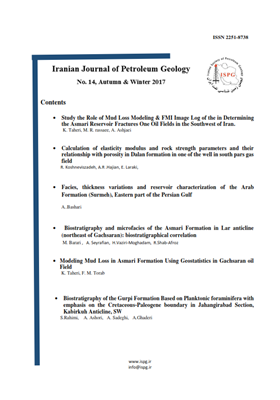مطالعه نقش مدلسازی هرزروی گل حفاری و نمودار تصویرگر FMI در تعیین شکستگی¬های مخزن آسماری در یکی از میادین نفتی جنوب غرب ایران
الموضوعات : Petroleum Reservoir Geology
کیومرث طاهری
1
![]() ,
محمدرضا رسایی
2
,
عباس اشجعی
3
,
محمدرضا رسایی
2
,
عباس اشجعی
3
1 - کارشناس ارشد اکتشاف نفت، دانشکده مهندسی معدن و متالورژی، دانشگاه یزد، یزد، ایران
2 - دانشیار انستیتو مهندسی نفت، دانشکده مهندسی شیمی، پردیس فنی، دانشگاه تهران، تهران، ایران
3 - رئیس طراحی و برنامه ریزی، معاونت زمین شناسی گسترشی، شرکت مناطق نفتخیز جنوب، اهواز، ایران
الکلمات المفتاحية: شکستگی ها, مخزن آسماری, نمودار تصویری FMI, توزیع تخلخل, نقشه هرزروی,
ملخص المقالة :
شناخت هرچه بیشتر مخازن نفت و گاز، در برداشت حداکثری هیدروکربور از آنها کمک شایانی می کند. در بررسی ویژگی های ساختمان های نفتی، مطالعه شکستگی های سنگ مخزن در مراحل تولید و توسعه میدان بسیار ضروری است. امروزه بکارگیری مدلسازی هرزروی و نمودارهای تصویرگر در تحقق این مسئله به زمین شناسان نفتی کمک شایانی می نماید. از آنجایی که اکثر مخازن ایران از نوع کربناته هستند، بررسی و شناسایی هرچه بیشتر شکستگی ها، میزان باز شدگی شکاف ها و توزیع تخلخل در مخزن آسماری میدان مورد مطالعه، جزو موثرترین عوامل در تولید هیدروکربن از این میدان محسوب می شود. یکی از بهترین راه های شناسایی و تفسیر زمین شناسی درون چاه، استفاده از نمودار تصویری FMI است، که می تواند تصاویری با کیفیت بالا از چاه ایجاد کند. به کمک تصاویر تهیه شده، می توان انواع شکستگی ها، تخلخل، توزیع فضاهای خالی دیاژنتیکی و تخمین روند تراوایی را مشخص کرد. در این مقاله ابتدا، ساختار و نحوه عملکرد نمودار تصویرگر FMI و سپس مشکلات حفاری و تولید در مخزن آسماری مورد ارزیابی قرار گرفته شد. در ادامه نقش کاربردی نمودار در تفسیر و تعیین میزان باز شدگی شکاف ها، توزیع تخلخل و میزان نفوذپذیری در 8 حلقه چاه در مخزن آسماری، مورد ارزیابی قرار گرفته است. در این مطالعه، شناسایی شکستگی های مخزن آسماری و نحوه گسترش این شکستگی ها در مخزن با استفاده از مدلسازی هرزروی، تفسیر نمودار تصویرگر FMI و تاثیر این شکستگی ها بر تخلخل و تراوایی مخزن انجام شد. در این مطالعه مشخص شده است که، شکستگی های شناسایی شده در چاه ها انطباق بسیار خوبی با نقشه های هرزروی گل حفاری و گسل های پی سنگی در تاقدیس مخزن آسماری دارد.
1. Taheri, K., et al., Correction Investigating the Design of Casing Pipes Using Drilling Data Analysis in Bangestan Wells, One of the Oil Fields in the Southwest of Iran. Journal of Petroleum Geomechanics, 2018. 2(1): p. 41-54
. 2. Taheri, K. and A.H. Morshedy, Three-dimensional Modeling of Mud Loss Zones Using the Improved Gustafson-Kessel Fuzzy Clustering Algorithm (Case Study: One of the South-western Oil Fields). Journal of Petroleum Research, 2017. 27(96-5): p. 82-97
. 3. Taheri, K. and F. Mohammad Torab, Applying Indicator Kriging in Modeling of Regions with Critical Drilling Fluid Loss in Asmari Reservoir in an Oil Field in Southwestern Iran. Journal of Petroleum Research, 2017. 27(96-4): p. 91-104
. 4. Taheri, K., & Torab, F. M. (2017). Modeling Mud Loss in Asmari Formation Using Geostatistics in RMS Software Environment in an Oil Field in Southwestern Iran. Iranian Jurnal of Petroleum Geology, 11(6), 1-10. http://rimag.ricest.ac.ir/fa/Article/33820
. 5. Alizadeh, M., Movahed, Z., Junin, R., Mohsin, R., Alizadeh, M., & Alizadeh, M. (2015). Finding the Drilling Induced Fractures and Borehole Breakouts Using Image Logs. Journal of Advanced Research, 10(1), 9-30
. 6. Taheri, K. (2016). Prediction & Modeling of Mud Circulation Loss Using Geostatistical Methods In Asmari Reservoir, Gachsaran Oil Field, Yazd University, Iran
. 7. Davarpanah, A., Kakoli, M., & Ahmadi, M. (2016). Analysis of Fractured Reservoir Structure by Interpretation of FMI and VSP Logs. J Marine Sci Res Dev 6: 216. doi: 10.4172/2155-9910.1000216 Page 2 of 5 Volume 6• Issue 6• 1000216. Receiver’s correction
. 8. Ezati, M., Soleimani, B., & Moazeni, M. S. (2014). Fracture and horizontal stress analysis of Dalan Formation using FMI image log in one of southwestern Iranian oil wells. Journal of Tethys, 2(1), 1-8
. 9.
Ragan, D. M., & Ragan. (1985). Structural geology. John Wiley & Sons. 10. Riskha, H., Syafri, I., Ismawan, I., & Natasia, N. (2017). Characterization of Basement FRACTURE reservoir in FIELD ‘X’, South Sumatera Basin, based on the analysis of core and Fmi log. Journal of Geoscience, Engineering, Environment, and Technology, 2(2), 155-165
. 11. Khoshbakht, F., Memarian, H., & Mohammadnia, M. (2009). Comparison of Asmari, Pabdeh and Gurpi formation's fractures, derived from image log. Journal of Petroleum Science and Engineering, 67(1-2), 65-74
. 12. Slim, M. I. (2007). Borehole-image log interpretation and 3D facies modeling in the Mesaverde group, Greater Natural Buttes field, Uinta basin, Utah Colorado School of Mines
]. 13.
Nelson, R. (2001). Geologic analysis of naturally fractured reservoirs. Elsevier. 14.
Slatt, R. M. (2006). Stratigraphic reservoir characterization for petroleum geologists, geophysicists, and engineers. Elsevier. 15. Sanaee, R., Shadizadeh, S. R., & Riahi, M. A. (2010). Determination of the stress profile in a deep borehole in a naturally fractured reservoir. International Journal of Rock Mechanics and Mining Sciences, 47(4), 599-605
. 16.
Serra, O. (1989). Formation MicroScanner image interpretation. Schlumberger Educational Services.
17.
Tingay, M., Reinecker, J., & Müller, B. (2008). Borehole breakout and drilling-induced fracture analysis from image logs. World Stress Map Project, 1, 8. 18. Wang, R., Song, H., Tang, H., Wang, Y., Killough, J., & Huang, G. (2016). Analytical modeling of gas production rate in tight channel sand formation and optimization of artificial fracture. SpringerPlus, 5(1), 1-14
. 19. Vatandoust, M., & Farzipour Saein, A. (2017). Prediction of open fractures in the Asmari Formation using geometrical analysis: Aghajari Anticline, Dezful Embayment, SW Iran. Journal of Petroleum Geology, 40(4), 413-426
.


